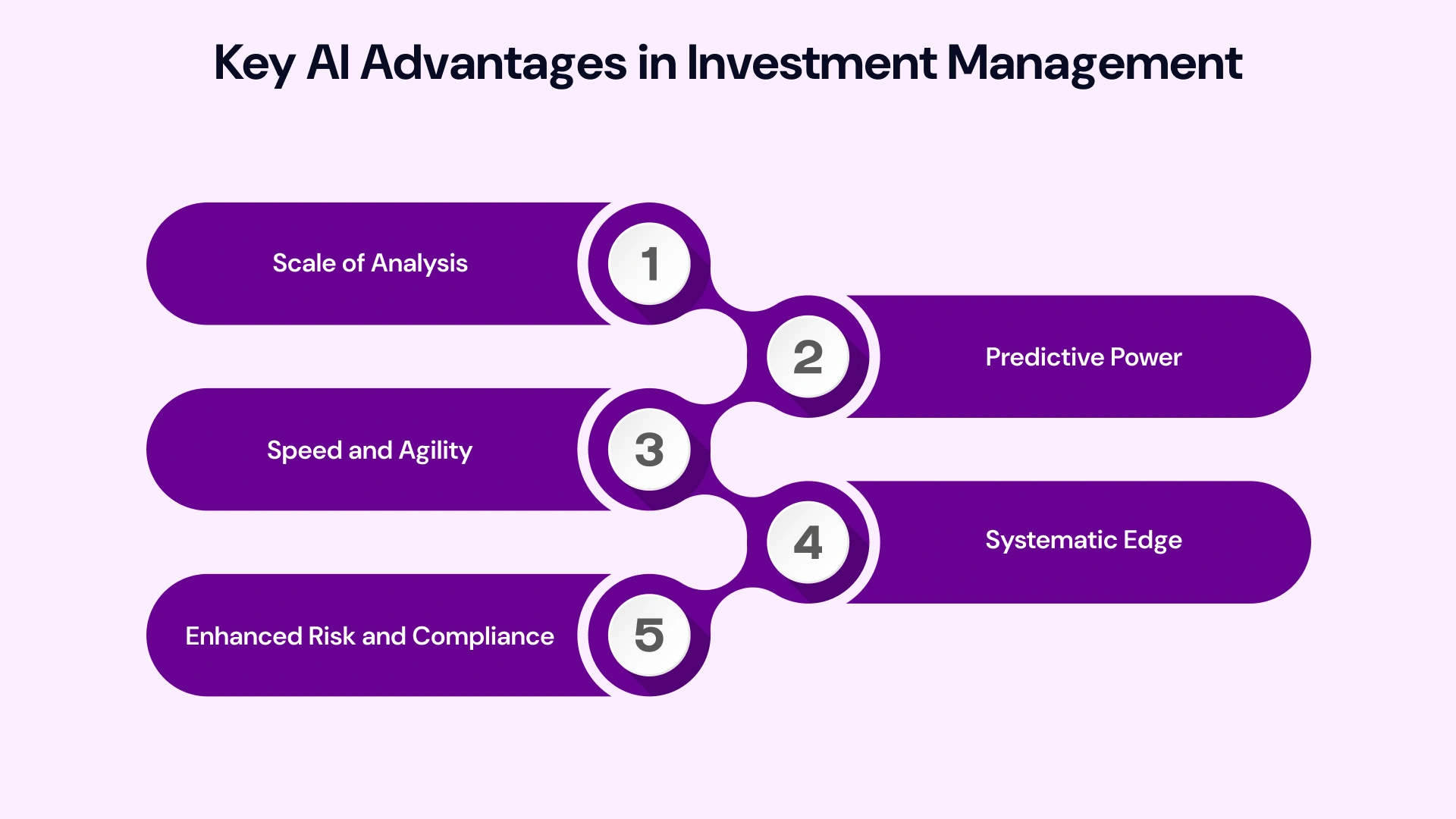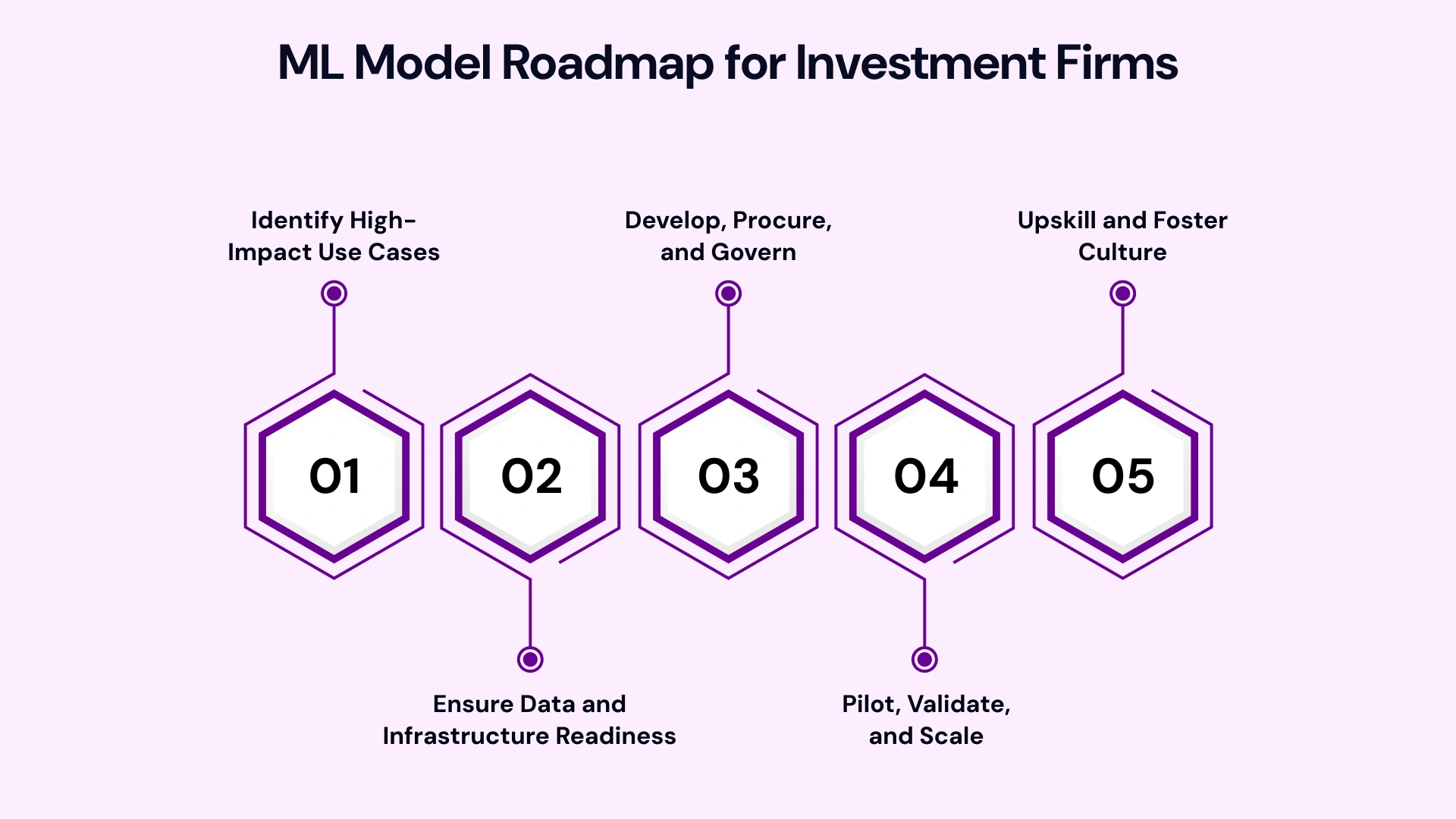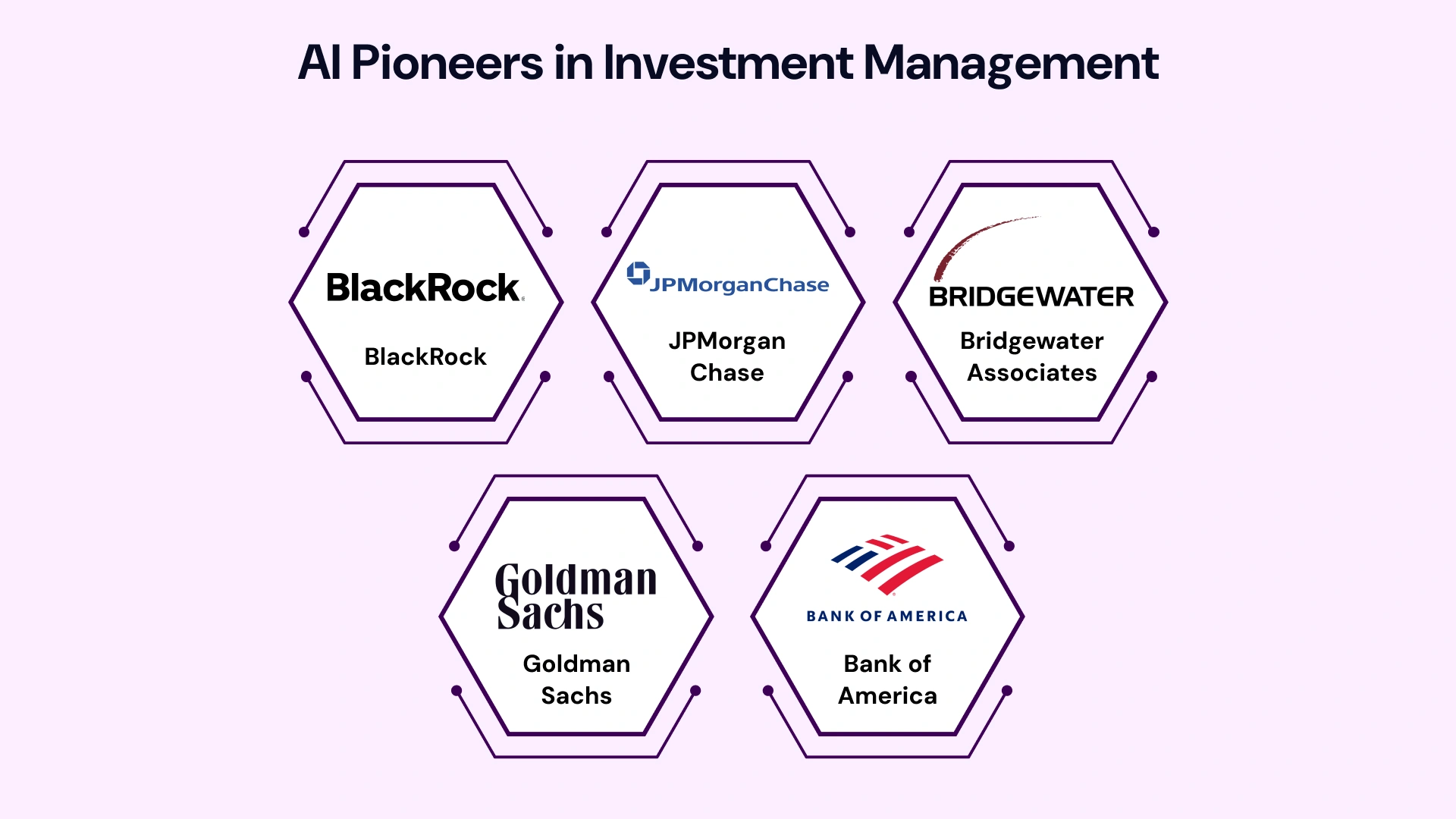The intersection of Artificial Intelligence in asset management and modern data strategy marks the most significant transformation the finance sector has seen since the rise of quantitative investing. For Chief Information Officers (CIOs) and Chief Data Officers (CDOs) in North America, this isn't a futuristic concept; it's a present-day mandate.
Globally, over half of hedge fund professionals now leverage AI in investment management or machine learning in their processes. This seismic move towards data-driven investment decisions and AI-powered portfolio optimization compels leaders to ask: Is our firm's data truly AI-ready?
The answer determines competitive survival. CIOs and CDOs must pivot from simply managing technology to strategically operationalizing data, embracing robust governance, and establishing an AI implementation roadmap for asset managers.
Why AI and ML Matter in Capital Markets: Beyond Efficiency
The strategic adoption of Artificial intelligence in asset management and machine learning in fund management is fundamentally restructuring the value chain of Capital Market IT Services. It's moving beyond mere cost reduction and workflow automation to become a critical factor in alpha generation and AI-driven risk assessment in investments.

AI in investment management offers five core advantages that traditional finance cannot match:
- Scale of Analysis: AI systems can instantaneously process petabytes of both structured (market prices, historical trades) and unstructured data (news sentiment, satellite imagery, corporate filings, social media) to detect subtle, non-linear patterns that human analysts would miss. This capability directly fuels AI analytics for portfolio managers.
- Predictive Power: Using machine learning, firms can move from descriptive analytics ("What happened?") to predictive analytics ("What is likely to happen and when?"). This provides a dynamic, forward-looking lens for capital allocation.
- Speed and Agility: Automated models enable continuous portfolio monitoring and real-time adjustments, facilitating a truly data-driven investment decision process that adapts to sudden market shifts faster than any manual process.
- Systematic Edge: The disciplined, emotionless execution of AI-powered strategies allows for sustained, systematic outperformance, making the AI-based asset management system a cornerstone of modern finance technology.
- Enhanced Risk and Compliance: AI algorithms constantly monitor complex regulatory changes, internal policies, and portfolio exposures in real time. This ensures proactive compliance, reduces human error in reporting, and identifies new, subtle risk correlations far beyond human capacity.
These real-world benefits are forcing executive leaders to view AI not as a tool, but as the new core competency of an AI for asset management firm.
Data Readiness: The Foundational Pillar for AI Success
The single biggest determinant of AI's success in investment management is data readiness. Without clean, comprehensive, and well-governed data, even the most sophisticated ML models are inert. CIOs and CDOs must prioritize building a modern data stack for asset management to ensure data quality and readiness for financial AI.
The Modern Data Stack for Asset Management
Operationalizing data for investment firms demands a departure from siloed, legacy databases. The goal is to create a unified, intelligent data ecosystem:
- Centralized and Enriched Data Fabric: Investment firms must use modern data fabric architectures to integrate and centralize data from disparate sources. This includes internal trading logs, CRM data, compliance records, and external feeds like alternative data and ESG scores. The fabric unifies data silos, providing accessible, real-time, and governed data for ML models in finance.
- Data Quality and Observability: Data governance in investment management is paramount. AI-powered data observability tools must continuously monitor data quality, detect anomalies, and trace data lineage to ensure the integrity of the inputs. AI models are only as good as the data they ingest, making this a non-negotiable step for all financial AI initiatives.
- Contextual Intelligence: Raw data is insufficient. It must be enriched with metadata—contextual information that describes the data—and semantic layers, allowing models to understand the meaning behind the data. This supports multimodal data processing, a critical capability for advanced AI analytics for portfolio managers.
CIO & CDO Best Practices for Data Modernization
The CDO challenges in data modernization are significant, often involving complex legacy architecture. The strategy should focus on intelligent, incremental change:
- Augment, Don't Rip-and-Replace: Extend legacy systems with data fabric capabilities for integration and governance, avoiding the time and cost of an immediate, full-scale replatforming.
- Embed AI-Native Capabilities: Integrate AI-specific technologies like vector search and Retrieval-Augmented Generation (RAG) into the data layer. This is crucial for unlocking the full power of GenAI in investment research, allowing fund managers to query massive document troves using natural language and receive contextually relevant summaries.
- Prioritize Auditability and Compliance: Establish immutable data lineage and audit trails. This is vital for regulatory compliance, model explainability, and mitigating the risks associated with bias, ensuring responsible AI for smarter fund decisions.
ML Model Adoption in Investment Firms: A Strategic Roadmap
The transition from a proof-of-concept AI project to enterprise ML model adoption in finance requires a clear, strategic AI implementation roadmap for asset managers—a key focus for the CIO AI strategy in investment firms.
The Structured Adoption Roadmap
For AI and ML in Capital Marketing to succeed, the process must be structured and iterative:

1. Identify High-Impact Use Cases:
Don't start with the technology; start with the business problem. Pinpoint areas where AI in investment management can drive immediate, measurable value, such as:
- Algorithmic Trading: Optimizing execution and order routing.
- Risk Management: Real-time counterparty and market risk exposure calculation.
- Client & Distribution: Personalizing client communications and optimizing marketing automation trends for fund managers.
- Compliance: Automated surveillance and regulatory reporting.
2. Ensure Data and Infrastructure Readiness:
Before building ML models for fund performance, validate the robustness of the data foundation. This involves deploying scalable cloud platforms and securing budget for a comprehensive data infrastructure for asset management firms.
3. Develop, Procure, and Govern:
Decide on a 'buy vs. build' strategy. Whether you build proprietary asset management artificial intelligence models or procure vendor solutions, the focus must be on transparency, modularity, and security. Implement robust machine learning governance for CIOs from the outset.
4. Pilot, Validate, and Scale:
Test models in controlled, live environments (pilot programs). Use continuous feedback loops to refine models and measure their ROI. Only after clear validation should the model be scaled enterprise-wide and integrating AI into fund operations.
5. Upskill and Foster Culture:
The final—and arguably most important—step is to invest in your people. Upskill both data science teams and portfolio managers to foster cross-disciplinary collaboration—the human element in a data-driven transformation in investment firms.
Over 60% of executives cite skill gaps and 70% report cultural resistance as primary hurdles to enterprise AI adoption in financial services. To overcome these:
- Foster Data Fluency: Implement training programs for all staff—not just quants—so they can understand, trust, and interpret AI outputs.
- Institutionalize Agile Change Management: Frame AI transformation for CIOs in asset management as an agile, continuous process rather than a one-off IT project to alleviate resistance.
- Align Strategy: Ensure every AI initiative is clearly aligned with the firm's long-term business goals, demonstrating that asset management technology is an enabler of strategy.
AI Applications in Fund and Portfolio Management
The true value of AI in investment management is revealed through its application across core investment functions, enabling smarter fund decisions.
Predictive Analytics for Investment Strategy
AI-sequenced predictive analytics allow for the discovery of alpha that traditional methods miss. By integrating real-time market sentiment, historic price movements, and a vast array of alternative data, AI systems deliver more precise risk forecasts and actionable signals.
- Dynamic Portfolio Optimization: AI-powered portfolio optimization goes beyond static asset allocation. Models can continuously rebalance based on live data, potentially increasing risk-adjusted returns by dynamically adjusting the asset mix.
- Early Risk Detection: Risk management shifts from a reactive compliance function to a proactive intelligence system. AI identifies subtle correlations and tail risks across a portfolio, flagging emerging vulnerabilities long before they impact fund performance.
- Systematic Quantitative Investing: AI in investment management is the core of modern quantitative investing, allowing quants to test, deploy, and manage sophisticated strategies based on complex, multi-factor models.
The Emerging Power of Generative AI
The Use Case of GenAi in Capital Marketing is rapidly expanding, introducing revolutionary capabilities:
- Enhanced Investment Research: Generative AI can read, summarize, and synthesize thousands of pages of corporate filings, analyst reports, and news articles in minutes, providing research teams with concise, contextually accurate summaries and even drafting preliminary research reports.
- Private Equity Deal Sourcing: GenAI can analyze vast, non-traditional datasets on private companies—including intellectual property filings, job postings, and web traffic—to identify potential deal targets that meet specific investment criteria.
- Client Engagement and Marketing: GenAI automates the creation of personalized client reports, pitch books, and tailored digital outreach, supporting marketing technology strategies for asset management firms by generating content at scale.
Leading quantitative firms have used AI for decades, but are now pushing into generative models. They use GenAI to create complex "synthetic" financial data to train more robust trading models and avoid overfitting to limited historical data.
Furthermore, they employ advanced NLP to analyze the "shadow economy" of unstructured data—from corporate filings and scientific journals to global shipping logs—to identify non-obvious signals for their algorithmic trading strategies.
Governance and Model Lifecycle Management
As AI in investment management becomes central to fiduciary duty, governance moves from a checkbox exercise to a critical operational function. Machine learning governance for CIOs ensures accountability, fairness, and compliance throughout the model's life.
Machine Learning Governance for CIOs: Building Trust
For executive leaders, embedding governance means ensuring ethical compliance and managing the 'black box' problem:
- Model Audit Trails and Explainability (XAI): Every model must be auditable and explainable. Building ML models for fund performance requires a transparent design. XAI ensures that fund managers and regulators can understand how and why a model arrived at a specific decision.
- Bias Mitigation and Ethical AI: Data governance must include mechanisms to identify and neutralize bias in training data, ensuring that algorithms are fair and comply with increasingly strict ethical guidelines. This is a primary focus for AI and data management for fund leaders.
- Continuous Monitoring and Validation: The AI model lifecycle management in fund operations is continuous. Models decay over time as market conditions change. Technology for asset management must include automated systems for real-time performance monitoring and timely re-training or decommissioning.
Executive Guide: CIO AI Strategy
The Executive guide to AI in finance is clear: success hinges on a blend of technical modernization and cultural readiness.
Building Enterprise AI Adoption in Financial Services:
- Treat Data as a Financial Asset: CIOs must unlock value through rigorous use, transparent data governance in investment management, and continuous optimization, viewing the operationalization of data for investment firms as a direct value driver.
- Focus on Incremental, High-ROI Wins: Start with projects that deliver immediate, measurable ROI, such as automating post-trade reconciliation or enhancing real-time compliance checks. Use these successes to fund and scale larger, alpha-generating projects.
- Overcome Silos with a Composable Architecture: Invest in cloud-native, API-enabled, and modular data solutions. This composable architecture is essential for breaking down data silos in investment management and enabling rapid deployment of new ML models.
Strategic Outcomes: The Competitive Edge
Firms that strategically embrace AI-driven investment management are seeing tangible, competitive advantages:
Area of Impact | AI-Enabled Outcome | Strategic Benefit |
Returns | Up to 20% increase in risk-adjusted returns | Alpha Generation |
Risk | Real-time exposure and predictive loss modeling | Reduced Unexpected Losses |
Efficiency | Automation of research, reporting, and compliance | Cost Optimization & Scalability |
Client | Hyper-personalized portfolios and dynamic engagement | Enhanced Investor Loyalty |
Real-World Examples: AI Pioneers in Investment Management
The future of AI in investment management is being shaped by industry leaders who have successfully navigated the path from data readiness to scaled ML model adoption. These pioneers demonstrate that AI's impact extends across the entire value chain—from enhancing trading speed and generating alpha to hyper-personalizing client experiences and ensuring compliance.
Here are concrete examples of organizations driving this transformation:

BlackRock (Aladdin Platform & AI Labs):
Beyond its core risk analytics, BlackRock deploys AI to generate alpha and enhance client services. This includes using the best large language models (LLMs) and big data to rapidly construct and manage thematic investment portfolios (e.g., identifying companies involved in disruptive technologies like GLP-1 weight-loss drugs). Their AI-driven security analysis can process millions of data points from earnings calls and satellite imagery to uncover unique investment insights, moving beyond traditional fundamental analysis.
JPMorgan Chase (IndexGPT & AI Research):
JPMorgan is aggressively expanding its AI footprint, launching products such as IndexGPT—a suite of thematic investment indices created entirely with generative AI to analyze news and social media trends. The firm also deploys advanced deep learning models, such as LOXM, for high-speed, optimal trade execution, which learn from historical data to minimize costs and market impact for large client orders.
Bridgewater Associates (The Systematized Intelligence Lab):
The world's largest hedge fund is pioneering the use of AI to codify its investment principles. They are building a "systematized intelligence" platform that trains AI models on decades of the firm's fundamental research and decision-making processes. The goal is to create AI "assistants" that can help analysts test investment theses, model economic scenarios, and manage risk with depth and speed previously impossible.
Goldman Sachs (AI in Investment Banking & MARVIN):
While using predictive AI in its asset management arm, Goldman Sachs also leverages AI to enhance its core businesses. A key example is MARVIN (Multi-Asset Risk Vector Integrated Network), an internal platform that uses machine learning to provide real-time, cross-asset class risk modeling for traders. Furthermore, the firm uses generative AI in its investment banking division to rapidly analyze thousands of complex legal documents for due diligence and M&A deals, dramatically accelerating deal sourcing and execution.
Bank of America (Erica & askMERRILL):
Their AI-powered virtual financial assistant, Erica, has now handled over three billion client interactions. This use case highlights the deployment of AI and natural language processing for hyper-personalized client services, including proactive budgeting advice, fraud alerts, and cash flow insights. For its wealth management division, the "askMERRILL" tool helps financial advisors instantly access curated research and generate client-friendly explanations of complex market events.
Future Outlook: Sustained Impact and The Way Forward
The impact of AI in investment management will only accelerate. The future of AI in wealth management and investment planning promises fully adaptive, agentic AI systems that operate more autonomously, turning insights into execution at lightning speed.
For CIOs and CDOs guiding this AI transformation in asset management, the mandate is not just to keep the lights on, but to build the intelligent investment management technology that defines the firm's competitive edge.
The core message remains: AI in investment management is about the quality of your data, the rigor of your machine learning governance, and the commitment to a culture of continuous transformation. Those who invest strategically in data readiness and a structured ML model adoption will be the ones driving smarter fund decisions and delivering superior returns for their clients in the coming decade.
Choose VLink's Capital Market Expertise for Your Brand
Navigating the AI adoption journey in capital markets, particularly for mission-critical functions like compliance, risk, and trading, requires more than just technology—it demands deep domain expertise and a proven, strategic approach. This is where VLink’s specialized Capital Market IT Services become invaluable.
The Core:
- AI-Powered Compliance and Risk: VLink leverages predictive AI models and real-time data integration to drive tangible business outcomes. For example, their AI-driven compliance solutions have reportedly led to up to a 45% reduction in compliance costs and 80% faster reporting cycles, significantly enhancing audit readiness and lowering the risk of regulatory breaches.
- Accelerated Performance: In trading, VLink's solutions enable 30% faster trade execution through seamless, real-time data integration and intelligent alerting. Their predictive AI models also deliver a 40% boost in risk forecasting accuracy, enabling your teams to respond instantly to market events.
- Holistic Digital Transformation: our dedicated team offers end-to-end support for modernizing legacy systems, ensuring a robust data foundation—a critical prerequisite for successful AI adoption. Their expertise covers cloud, automation, and intelligent workflows, ensuring your digital transformation is not piecemeal but strategic, scalable, and secure.
By partnering with VLink, you gain a strategic ally that ensures your AI initiatives move beyond mere pilot projects. They help you build the compliant, high-performing, and resilient infrastructure necessary to transform complex financial data into meaningful, actionable insights and sustain a competitive edge.
Conclusion: The Holistic Imperative
For CIOs and CDOs in investment management, the AI revolution is an imperative that demands a holistic strategy. Moving beyond incremental efficiency gains, the goal is now to use AI to generate genuine alpha. Success hinges on establishing a solid data foundation—clean, governed, and unified—which acts as the crucial fuel for resilient models.
Critically, firms must adopt an augmentation, not replacement, strategy, ensuring human experts retain strategic oversight while AI handles the data-intensive work. By rigorously embedding governance and investing in your talent's AI literacy, you can move confidently from fragmented pilots to scalable, compliant, and transformative AI systems, securing a decisive competitive advantage in the capital markets.
Are you ready to move beyond fragmented pilots to a comprehensive AI strategy roadmap? Our firm specializes in Capital Market IT Services, providing end-to-end expertise in operationalizing data for investment firms, designing robust data infrastructure for asset management firms, and developing fully governed, high-impact AI and ML for Capital Markets models.
Contact us today to schedule a strategic consultation and discover how AI can redefine your firm's success.










 Shivisha Patel
Shivisha Patel
















